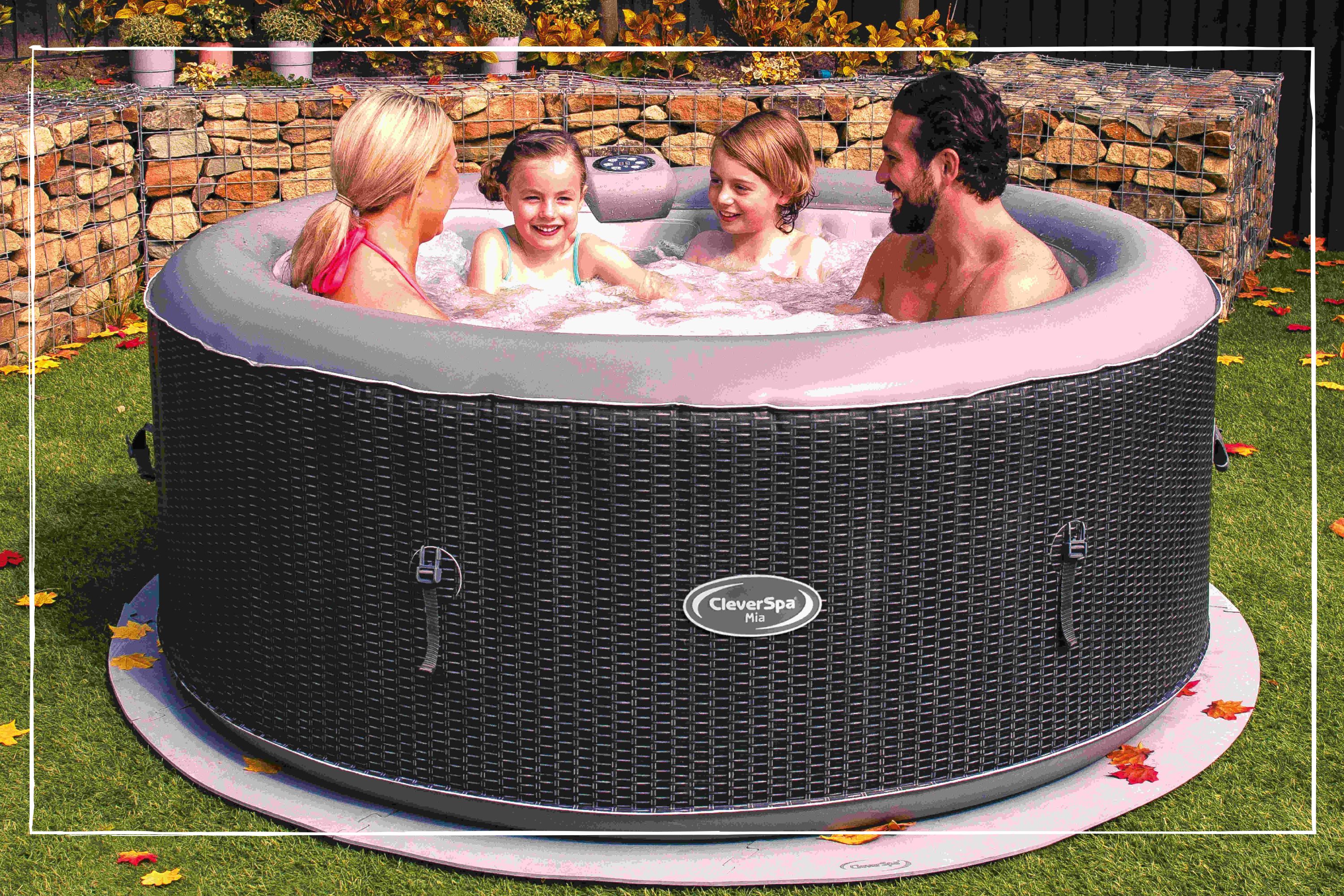How much does it cost to run a hot tub and is it a good choice for your family?
Make sure you know how much it costs to run a hot tub before you buy one for your family

Sarah Handley

How much does it cost to run a hot tub is a question you might be asking yourself if you’re thinking of buying one for some family summer fun. Energy prices have been a hot topic for the last couple of years, and although the energy price cap has fallen as of 1 July, families remain concerned about how much their energy bills will cost.
So, if you’re thinking of investing in a hot tub for when summer starts, it’s important to know how much running one will add to your energy bills.
Energy expert at business utilities retailer Love Energy Savings, John-Paul Drake, told us: “Energy prices have been a constant worry for Brits in recent years and just because the central heating has been switched off, that doesn’t mean hefty electricity bills automatically take the summer off.
“Hot tubs gobble up a fair bit of energy to get up to temperature and there’s the cost of filling it with water to consider too, so as fun as they are, hot tubs have the potential to give your bank balance a beating.”
How much does it cost to run a hot tub?
It currently costs around £1.05 an hour to run an inflatable hot tub with a 2kW heater and a 1.5kW water pump (3.5kW in total). This is based on the current unit price of electricity under the energy price cap being 30p/kWh.
A hot tub’s heater is the main source of energy consumption and this can use between 1.5.kW and 6kW of power, depending on the model and size of the tub. On top of this, there’s the energy used by the pump which is typically 1.5kW.
To work out how much your specific hot tub costs to run, divide the wattage by 1,000. This will tell you how many kilowatt hours of electricity your hot tub uses. Then multiply the answer by the price you pay per kilowatt of electricity, as stated on your latest energy bill. If you’re not sure, use the 30p set by the price cap.
Parenting advice, hot topics, best buys and family finance tips delivered straight to your inbox.
To give another example, if your hot tub had a 4.5kW heater and a 1.5kW pump (6kW in total), it would currently cost you £1.80 an hour to run. However, WhatSpa? points out that a heater with a larger kW rating will heat the water faster, so you won’t need it on for as long as one with a lower rating.
The exact costs of running a hot tub will also depend on a variety of other factors, as co-founder of price tracking website alertr.co.uk, Andy Barr, explains: “How much it costs to run a hot tub is dependent on the size and model, the ambient outside temperature, the temperature you like the hot tub to be heated to, how long and how often you plan to use it, how long you have the jets turned on for, and your current electricity tariff.”
The larger your hot tub, the more water it will contain - and the greater the volume of water that needs heating, the more it will cost you. Similarly, the higher the water temperature and the more you use the jets or massage system, the more you’ll be paying for your energy bills.
What's the cheapest way to heat a hot tub?
One of the cheapest ways to run a hot tub is to fill it with water from a hot tap as this will reduce the amount of time and energy required to heat the water.
Energy expert John-Paul Drake says: “A lot of people make the mistake of filling their hot tub from the hosepipe, which is possibly the iciest water source at home. You can do your energy bills a big favour by starting your hot tub up with warm (but not hot or boiling) water. This means the pump's heater isn’t doing all the hard work to bring the water up to temperature.”
It’s also sensible to only fill your hot tub to the minimum line and lower the temperature of the water by a degree or two as this will ensure your hot tub uses less energy.

Marketing director at water sports retailer Wave, Ben Cook, adds: “Heating your tub when the outside temperature is at its highest is also wise, and this will help to speed up the process, reducing the amount of electricity needed.”
If you’re yet to buy a hot tub, it’s crucial to do some research first and think about the type of tub you want to buy. Inflatable hot tubs, like this Lay-Z-Spa from Amazon, tend to lose more heat as they have poorer insulation, so it can be worth looking into more energy-efficient, permanent options instead.
“Some of the cheapest models on the market are actually the most expensive to run,” says Simon Hughes from Price Your Job. “So, if you haven’t bought a hot tub yet, pick a model with good insulation on all sides such as multiple foam layers. Look for features such as eco-controls, heat-recycling technology and a low-energy pump.”
Further energy-saving tips include positioning your hot tub in a sheltered location to protect it from wind and heat loss, using an insulated, snug-fitting cover, again you can pick one of these up from Amazon for between £25- £100, when not in use, and cleaning the filter each week.
Is it cheaper to leave a hot tub running all the time?
This will depend on how often you plan to use your hot tub as a lot of the energy consumption comes from heating the water.
Price Your Job’s Simon Hughes explains: “Leaving your hot tub on all the time will obviously use more energy. But if you are using your tub daily or at least three times a week, then it’s worth leaving it on. This is because tubs use a lot of energy heating up the water, so reheating it everyday or every other day will be more costly than leaving it running.”
What other costs do you need to consider with a hot tub?
As well as electricity costs, there are a host of other costs you need to consider before investing in a hot tub, such as the water treatment chemicals, hot tub cover and buying a new filter at least once a year.
Marketing manager at Lay-Z-Spa, Tom Drakett, says: “A small cost to consider is chemicals as the water needs to be treated regularly. These don’t cost much and you can get a starter kit for less than £30 which will last a long time. Water should be changed every three months.”
You can pick up a starter kit from the likes of B&Q, Argos, B&M or Amazon.
William Hobbs at trades matching site My Job Quote, adds: “It’s also a good idea to have the hot tub serviced on a regular basis to keep it in the best condition. This may save you from having to fork out on expensive repair costs down the line. A service will cost around £100 - £140 on average.”
Be sure to give all of these costs careful consideration before deciding whether a hot tub is a worthy investment for your family this summer.

Is it safe for kids to use a hot tub?
Safety of all family members should be a top priority if you have or plan on having a hot tub at home.
Goodto.com's Money Editor Sarah Handley says: "Children younger than five years old shouldn't use a hot tub, as the risk of dehydration and drowning is much higher than older children. If you allow your older children to use the hot tub, it's advisable to lower the pre-set temperature of the hot tub, prevent them from submerging their whole bodies and only allow them to use it for 5-10 minutes at a time. It goes without saying that children should be supervised at all times when using a hot tub, and to make sure they keep hydrated."
Can I use a hot tub if I am pregnant?
The NHS advises those who are pregnant to avoid using a hot tub as it can increase the risk of overheating, fainting and dehydration, all of which can be harmful during pregnancy. That advice extends to saunas and steam rooms too.

Mum of two, Rachel is a freelance personal finance journalist who has been writing about everything from mortgages to car insurance for over a decade. Having previously worked at Shares Magazine, where she specialised in small-cap stocks, Rachel developed a passion for consumer finance and saving money when she moved to lovemoney.com. She later spent more than 8 years as an editor at price comparison site MoneySuperMarket, often acting as spokesperson. Rachel went freelance in 2020, just as the pandemic hit, and has since written for numerous websites and national newspapers, including The Mail on Sunday, The Observer, The Sun and Forbes. She is passionate about helping families become more confident with their finances, giving them the tools they need to take control of their money and make savings. In her spare time, Rachel is a keen traveller and baker.
- Sarah HandleyMoney Editor, GoodtoKnow